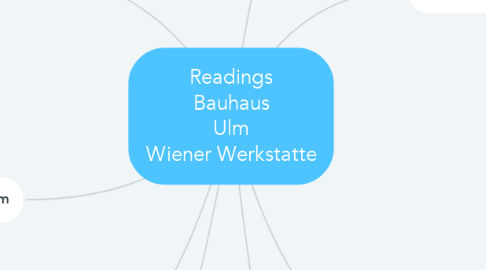Readings Bauhaus Ulm Wiener Werkstatte
by Matt Wan


1. Wiener Werkstatte
1.1. Guild in Vienna formed in 1902
1.2. Promoted Gesamtkunstwerk "total work of art"
1.3. Art forms as visual designs
1.4. High quality instead of mass production
1.5. Designers had to develop their own style
1.6. Concern with taste rather than transformation of society
2. Utilitarianism
2.1. Jeremy Bentham
2.1.1. Advocate for liberalism
2.2. Value theory
2.2.1. Happiness and absence of suffering isvalue
2.3. Theory of right action
2.3.1. maximize value
2.4. The happiness of one person is less valuable than the happiness of many
3. PARC
3.1. Architects of information
3.2. An assembled team of experts
3.3. Innovations in the printing industry
4. The Great Exhibition
4.1. Development of British manufacturing
4.2. Development of museums
4.3. International co-operation
5. Bauhaus
5.1. Artists and craftsmen working together
5.2. Aritsts and craftsmen learning from each other
5.3. Harmonizing art and technology
5.4. Designers working on industrial production
5.5. Egalitarian philosophy
6. Ulm Model
6.1. Ulm school of design was very influential
6.2. Discovered by Kapos
6.3. Post WWII
6.4. Purposed to reduce nationalism and militarism in Germany
6.5. Improve Germany's society
6.6. Supports the idea that a designer should adopt a critical reflective position on the social process of production
6.7. Max Bill arrived in Ulm in 1950s
6.7.1. No tension between design and market
6.7.2. Tried to "unalienate" industrial design
6.7.3. Advocated for designers to be in production process
6.8. Tomas Maldonado
6.8.1. Implications for design education adequate of professional practice
6.9. Failed because of lack of criticism during design process
6.10. Objective was to make the world rational and complete, industrial-based, and free
6.11. Unbalance between functionalism and socialism
7. IDEO
7.1. Collective group to design and innovate products
7.1.1. People from different backgrounds
7.1.2. Experts in their own fields working together
7.2. Thorough and extensive design process within a group
8. Scandinavian participatory design
8.1. AKA co-operative design or co-design
8.2. Students of Bauhaus school of design
8.3. An approach where everyone is involved in the design
8.4. Nordic design
8.4.1. White
8.4.2. Functional
8.4.3. Nature focused
8.5. Workplace democracy- creative design methods
8.6. Political entrepreneurs
8.7. Collective turns
8.7.1. democracy at work
8.7.2. cooperative design of computer systems
8.7.3. marginal design collectives publics in the making
8.8. Design turns
8.8.1. work oriented design
8.8.2. digital Bauhaus

